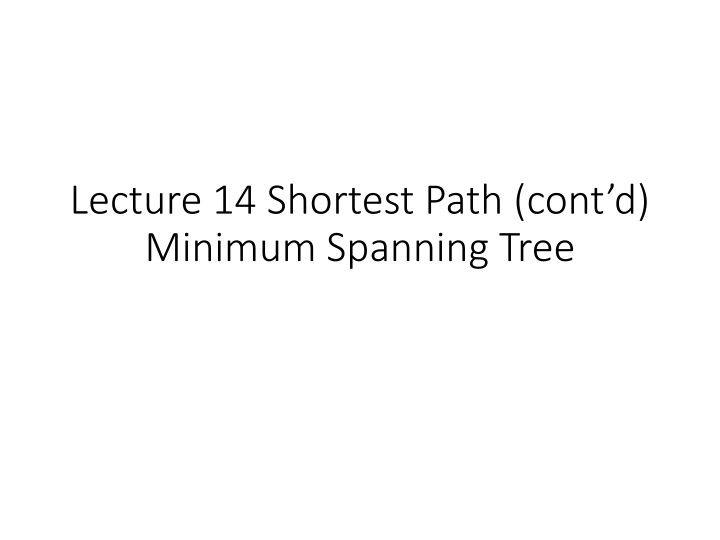Bellman-Ford Algorithm: Shortest Path with Negative Edge Length
The Bellman-Ford algorithm addresses the challenge of finding the shortest path in graphs with negative edge lengths, particularly useful in scenarios such as arbitrage in currency exchange rates. By utilizing dynamic programming and steps iteration, the algorithm efficiently detects negative cycles and determines the length of the shortest path. Practical implementation strategies, running time analysis, and methods for detecting negative cycles are explored in detail.
Download Presentation

Please find below an Image/Link to download the presentation.
The content on the website is provided AS IS for your information and personal use only. It may not be sold, licensed, or shared on other websites without obtaining consent from the author.If you encounter any issues during the download, it is possible that the publisher has removed the file from their server.
You are allowed to download the files provided on this website for personal or commercial use, subject to the condition that they are used lawfully. All files are the property of their respective owners.
The content on the website is provided AS IS for your information and personal use only. It may not be sold, licensed, or shared on other websites without obtaining consent from the author.
E N D
Presentation Transcript
Lecture 14 Shortest Path (contd) Minimum Spanning Tree
Shortest Path with negative edge length What is w(u,v) can be negative? Motivation: Arbitrage Image from wikipedia
Modeling arbitrage Suppose u, v are different currency, exchange rate is C(u,v) (1 unit of v is worth C(u,v) units of u) Let length of edge w(u,v) = log C(u,v) Length of a path = log of the total exchange rate Shortest path = best way to exchange money. Negative cycle = arbitrage.
Approach: dynamic programming with steps Bellman Ford algorithm: d[u, i] = length of shortest path to get to u with i steps ? ?,? + 1 = min ?,? ?? ?,? + ?(?,?) Shortest Path to a Predecessor Length of last step Question: How many steps do we need to take?
Nave implementation Slight modification: d[u, i] = length of shortest path to get to u with at most i steps ? ?,? + 1 = min{?(?,?), min ?,? ?? ?,? + ?(?,?)} Initialize d[s, 0] = 0, d[u, 0] = infinity for other u FOR i = 1 to n Initialize d[u, i] = d[u, i-1] for all i FOR all edges (u,v) IF w[u,v]+d[u,i-1] <= d[v,i] THEN d[v,i] = w[u,v]+d[u,i-1] IF there is a vertex such that d[u,n] <> d[u,n-1] THEN There is a negative cycle!
How to detect a negative cycle? When the graph has no negative cycle, a shortest path can only contain n-1 edges. (why?) If the graph has a negative cycle, then there is a vertex whose shortest path with n edges is shorter than all paths with at most n-1 edges.
Practical Implementation Running time: Each iteration takes O(m) time (O(1) per edge) There are n iterations. Total running time O(mn) In practice can be implemented to run efficiently for many graphs Only consider outgoing edges from u if d[u,i] < d[u,i-1] Use a queue to keep track of which vertices are updated
Minimum Spanning Tree Input: Undirected graph with edge weights Edge Weight: w[u,v] = cost of connecting two vertices u,v w[u,v] > 0 Goal: Select a subset of edges such that every pair of vertices can be connected by these edges. Minimize the total weight of the edges selected. Observation: Only need to select n-1 edges and form a tree.
Key Property? Recall: Any sub-path of a shortest path is still a shortest path. Dynamic programming based algorithms. What properties does minimum spanning tree have?
Trees and cycles Adding any non-tree edge to a tree will introduce a cycle For a tree with a cycle, removing any edge in the cycle results in a tree. Basic operation: add an edge and remove another edge in the cycle created (swap).
Why swap? We will use this to give greedy algorithms for MST. Recall: Greedy algorithm, general recipe for proof Assume optimal solution is different from the current solution Try to find the first place the two solutions differ Try to modify OPT so that it looks similar to ALG (use swap here!)
Cuts in Graphs A cut is a subset of edges that separates the vertices into two parts A cut is usually specified by a subset of vertices ?, ? , S is one part of the vertices, ? is the set of remaining vertices.
Question for the greedy algorithm Given a cut, which edge should we use? Idea: Use the shortest one (with minimum cost). (Note: Eventually we may use multiple edges in the cut, this only decides which is the first edge we use)
Key Property Key Lemma: Suppose F is a set of edges that is inside some MST T, if ?, ? is a cut that does not contain any edge in F and e is the minimum cost edge in the cut, then it is safe to add e to F. ? ? ? for some MST T
General Algorithm for MST Initialize the tree to be empty. (initially a subset of some MST) Repeat Find a cut that does not have any edge in the current tree Add the min cost edge of the cut to the tree (by Key Lemma: still a subset of some MST) Until the tree has n-1 edges (Now we already have a tree, so it must be a MST)























